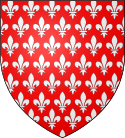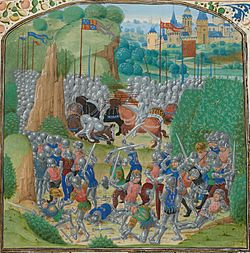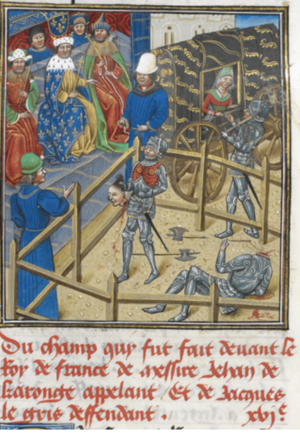Jean de Carrouges facts for kids
Quick facts for kids
Sir Jean de Carrouges
|
|
|---|---|

Jean de Carrouges coat of arms De gueules fleurdelisé d'argent.
|
|
| Born | c. 1330s Carrouges, Normandy |
| Died | 25 September 1396 (aged ~66) Nicopolis, Ottoman Empire |
| Allegiance | |
| Battles/wars | Hundred Years' War; campaigns in Normandy and Scotland, Crusade of Nicopolis |
| Spouse(s) |
Marguerite de Thibouville
(m. 1380) |
Sir Jean de Carrouges IV (born around the 1330s – died September 25, 1396) was a brave French knight. He managed lands in Normandy and served under Count Pierre d'Alençon. He also fought for Admiral Jean de Vienne in battles against England.
Jean de Carrouges became famous in medieval France for fighting in one of the last judicial duels allowed by the French king. This special duel was a fight to the death to decide who was telling the truth. Carrouges won the duel. Many important French nobles, including King Charles VI, watched this event. Thousands of ordinary people from Paris also came to see it. Famous historians like Jean Froissart wrote about it later.
People described Carrouges as a strong and brave warrior. He had a military career that lasted forty years. He fought well in Normandy, Scotland, and Hungary. He was also involved in the royal court in Paris. He served as a royal bodyguard. Carrouges was often in legal disputes. The true story of what led to his famous duel is still talked about today.
Contents
Who Was Jean de Carrouges?
Jean de Carrouges IV was born in the late 1330s. He was the oldest son of Sir Jean de Carrouges III. His family lived in the village of Sainte-Marguerite-de-Carrouges. His father was a knight and a respected soldier. He had fought in the Hundred Years' War. For his service, he became a knight and the Viscount of Bellême. This title meant he commanded a castle and was like a sheriff.
Jean de Carrouges IV grew up learning to be a soldier. He joined his father in fighting against the English. When he turned 21, he received some family lands to manage. He wanted to make his family's land holdings bigger. In 1367, English soldiers destroyed his family's castle and village. A new castle was built nearby.
Jean's First Marriage and Friendships
In the early 1370s, Carrouges IV married Jeanne de Tilly. She brought lands and money with her marriage. This helped Carrouges expand his family's estates. Soon after their wedding, Jeanne had a son. A close friend of Carrouges, Squire Jacques Le Gris, became the baby's godfather.
In 1377, Count Pierre d'Alençon became the new lord of Bellême. Carrouges and Le Gris both became his vassals. They joined the Count's court in Argentan. At first, Carrouges and Le Gris were friends. But Le Gris quickly became a favorite of Count Pierre. Le Gris received new lands and titles. Carrouges felt jealous and they became rivals.
Tragedy and New Battles
A year after joining Count Pierre's service, Carrouges faced sadness. Both his wife and son died from natural causes. After this, Carrouges left home. He joined the army of Jean de Vienne. He fought bravely against the English in Normandy. He distinguished himself in battles in Beuzeville, Carentan, and Coutances. This campaign lasted five months. Many of his men were lost during this time.
Jean's Second Marriage and Legal Troubles
In 1380, Carrouges returned home. He married Marguerite de Thibouville. She was the daughter of Robert de Thibouville. Her father was a controversial lord who had gone against the French king. Carrouges hoped to have an heir with Marguerite. People said she was "young, noble, wealthy, and also very beautiful."
Soon after his marriage, Carrouges started a lawsuit. He wanted to get back the valuable land of Aunou-le-Faucon. This land had been given to Jacques Le Gris. It used to belong to Marguerite's father. Carrouges believed he had a claim to it. The case went on for months. Count Pierre had to ask King Charles VI to confirm his ownership. This lawsuit made Carrouges even more disliked at Count Pierre's court.
More Disputes Over Land
Two years later, Carrouges was in court again. This time, it was about lands his recently deceased father had managed. Carrouges believed he should inherit the command of Bellême castle. But because of his earlier lawsuits, Count Pierre gave the command to someone else. Carrouges sued his lord again and lost. This further separated Carrouges from Count Pierre's circle.
In 1383, Carrouges tried to buy more land. He wanted to buy fiefs in Cuigny and Plainville. Count Pierre had to approve the sale. But because of their past problems, he refused. He made Carrouges give the properties to him. Carrouges had no choice but to obey. He blamed Jacques Le Gris for this new misfortune.
Fighting in Scotland

In late 1384, Carrouges attended a party. He met Le Gris there. They agreed to end their quarrel. Carrouges even introduced Le Gris to his wife, Marguerite. A few months later, in March 1385, Carrouges joined an army. He went with Jean de Vienne on a trip to Edinburgh. This army of about 3,000 soldiers planned to join the Scottish army. Their goal was to raid Northern England. This would distract English forces from France.
Carrouges and his men traveled to Sluys. They took a ship to Leith. In Scotland, they spent time gathering Scottish troops. The army moved south in July. They attacked villages and farms near the River Tweed. They also burned Wark Castle. The allied army continued south into Northumberland. They burned many villages and towns.
The English army, led by King Richard II, came to fight. The French were ready, but their Scottish allies retreated. The French had to retreat too. Outside Edinburgh, the Scottish army left. The French were alone and outnumbered. Vienne led his army south again. They attacked Carlisle but could not break its walls. On their way back north, they were attacked. Their supplies were destroyed, and many were captured. When they returned to Edinburgh, the Scots refused to help them. Many French soldiers died from disease or hunger. The French army returned to Flanders defeated.
Despite the expedition's failure, Carrouges fought well. He lost men and money. But he was awarded a knighthood on the battlefield. This greatly improved his social status. After returning from Scotland, Carrouges went to Paris. He collected his wages for the campaign. He left his wife with his mother in Capomesnil.
The Famous Trial by Combat
The duel was very rare at this time. So, a jousting arena at the Abbey of Saint-Martin-des-Champs was chosen. Both Carrouges and Le Gris were ill in the weeks before the duel. But they recovered with help from their families. Hundreds of people came to Paris to watch the fight. King Charles VI even delayed the duel by a month. He wanted to be there to see it. The new date for the combat was December 29, 1386.
In the months before the duel, Marguerite and the French queen Isabeau of Bavaria both had sons. Marguerite's son, Robert, was healthy. But the King's son was sickly and died on December 28. Instead of mourning, the King ordered celebrations. The duel was meant to be the highlight. Thousands of Parisians arrived at the Abbey early. The King and his family were there. Marguerite was also present, dressed in black. She sat in a carriage overlooking the field. If her husband lost, she would have been burned at the stake. This would have meant she was "proven" guilty of perjury (lying under oath).
The Duel Begins
The fighters entered the field in the early afternoon. They wore plate armour and rode horses. Each carried a lance, a longsword, a heavy battle axe, and a long dagger. Carrouges spoke first. He told the King and the crowd his accusations against Le Gris. Then Le Gris spoke. Le Gris was then made a knight. This made sure both men had equal standing in the fight.
Both knights then got off their horses. They swore oaths to God, the Virgin Mary, and St George. This meant they believed God would decide the winner. Finally, Carrouges went to his wife. He promised to return. He kissed her.
The field was cleared. The King ordered silence. Anyone who interfered or shouted would be punished. The knights got ready. At the signal, they charged at each other. Their lances hit but did not break. They turned and charged again, hitting each other's helmets. They charged a third time, breaking their lances. Then they drew their axes. They fought fiercely. Le Gris, who was stronger, injured Carrouges' horse. As the horse fell, Carrouges jumped clear. He killed Le Gris' horse with his own axe.
Now on foot, the knights drew their swords. Le Gris was still stronger. After several minutes, Carrouges slipped. Le Gris injured him. The crowd gasped. Carrouges used this chance to grab Le Gris' helmet. He pulled him to the ground. Le Gris' heavy armor made it hard for him to get up. Carrouges used his dagger handle to break the lock on Le Gris' faceplate. He tore it off, exposing Le Gris' face.
Carrouges demanded that Le Gris admit his guilt. Le Gris refused. He cried out, "In the name of God, I am innocent!" Since Le Gris would not confess, Carrouges killed him.
After the Victory
Carrouges stood over his defeated opponent. The crowd cheered. Pages rushed to help his wound. He then knelt before the King. The King gave him a prize of a thousand francs. He also gave him a royal income of 200 francs a year. Then, in an emotional moment, he greeted his wife.
With the crowd following, Jean and Marguerite de Carrouges rode from the abbey. They went to the cathedral of Notre-Dame de Paris. There, they gave thanks for the victory. A few weeks later, Parliament gave Carrouges more money. He also received a position in the Royal Household. Carrouges tried again to claim the land of Aunou-le-Faucon. But Count Pierre, who owned the land, never forgave Carrouges. He kept the estates from him.
Royal Service and Final Battle
Over the next three years, Jean and Marguerite de Carrouges had two more children. They lived in Paris and Normandy. They benefited from their fame. In 1390, Carrouges became a chevalier d'honneur. This meant he was a bodyguard for the King. It was an important position with good pay.
The next year, he went to Hungary. His mission was to check on the threat from the Ottoman Empire. He was second in command to Jean de Boucicaut, a famous soldier. This showed how important Carrouges had become after the duel.
In 1392, Carrouges was with King Charles VI when the King became ill. Carrouges was present when the King had a mental breakdown. The King believed he was under attack. He lashed out at people around him. Carrouges and other bodyguards eventually calmed the King.
The Crusade of Nicopolis
In early 1396, a new crusade began. The French army moved to fight the Turks in the East. Jean de Carrouges joined his old commander, Admiral Jean de Vienne. The army traveled through Central Europe. They joined with the Hungarians. They marched south, destroying towns along the Danube river. On September 12, they reached Nicopolis. They tried to capture the city but failed. They then began a siege.
Two weeks later, Sultan Bayezid I arrived with a large army. He challenged the crusaders to fight. The crusader army moved to meet him on September 24. But the French attacked too early. Their army was spread out. Bayezid gathered his forces. He defeated the crusaders in a fierce battle. Most of the allied army was destroyed. Thousands were captured and executed by the Turkish troops.
We do not know exactly how Sir Jean de Carrouges died. It is likely he fell near his commander, Jean de Vienne. Their forces were trapped and wiped out. After his death, his lands went to his 10-year-old son, Robert de Carrouges. A painting of Jean and Marguerite de Carrouges was made. It was in the Abbey of St. Étienne in Caen. This painting celebrated his memory. Over time, the family and the painting became less known.
His family was later replaced by the Le Veneur de Tillières family. They owned the land and Château de Carrouges until 1936. The castle was restored in 1944. It is now managed by the Centre des monuments nationaux and is open to the public. The village of Sainte-Marguerite-de-Carrouges was also named after Marguerite de Carrouges.
Why Was This Duel So Important?
The judicial duel between Carrouges and Le Gris was very famous. It was one of the last allowed by the French government. Because so many people watched it, it became a well-known story. Historians like Jean Froissart wrote about it soon after. Later, other writers added their own details to the story.
The details of the case are very well recorded for a medieval trial. The records from the Parliament of Paris still exist. Jacques Le Gris' lawyer, Jean Le Coq, kept careful notes. These notes give a clear view of what happened. They also show that Le Coq himself doubted his client's innocence.
Later Stories and Modern Interest
Some old stories say that another man confessed to the crime before he died. This would mean that Le Gris was innocent. However, author Eric Jager says this story is "without basis." This false tale was repeated in many later sources. It was used to argue against trial-by-combat. Jager says that even the Encyclopædia Britannica had this false story until the 1970s.
Many other books have discussed the story. These include a section in Diderot's Encyclopédie and a work by Voltaire. In the 19th century, a descendant of Jacques Le Gris tried to prove his ancestor's innocence. More recently, Eric Jager wrote the book The Last Duel: A True Story of Trial by Combat in Medieval France in 2004. Jager is a professor of English Literature at UCLA.
Jager's book was made into a movie in 2021. It was called The Last Duel. Ben Affleck, Nicole Holofcener, and Matt Damon wrote the screenplay. Damon played Jean de Carrouges. Affleck played Pierre d'Alençon. Jodie Comer played Marguerite de Thibouville, and Adam Driver played Jacques le Gris. Ridley Scott directed the film.
Carrouges' duel is sometimes called the last authorized duel in France. But this is not correct. The actual last public duel allowed by the French king happened on July 10, 1547. It was between Guy Chabot de Jarnac and François de Vivonne. Jarnac won the duel, and Vivonne later died from his wounds.


